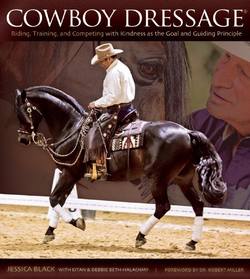Читать книгу Cowboy Dressage - Jessica Black - Страница 14
На сайте Литреса книга снята с продажи.
CHAPTER ONE
INTRODUCING COWBOY DRESSAGE
ОглавлениеThe first thing my brother asked me when I mentioned I had visited Debbie and Eitan Beth-Halachmy for the first time in years was, “Do they still live above the stables?”
Yes of course. What a wonderful way to live, we agreed: right above your horses, amidst beautiful scenery. Of course, it is easy for us to say. My brother has fond memories of riding his motorbike out to Wolf Creek Ranch to escape the hustle and bustle of Sacramento. I have spent most of my adult life in cities where I have had to drive anywhere from ten to forty-five minutes to see my horses. For us, having our horses close at hand seems a dream and a privilege. For Deb and Eitan, it is a way of life that has brought hard work along with the fulfillment that has come with Cowboy Dressage.
A visit to Wolf Creek Ranch, home of the Beth-Halachmys and the birthplace—if one place can be named—of Cowboy Dressage involves a slow winding drive through the beautiful scenery of Grass Valley in California (fig. 1.1). No matter which way you go, you get the curves that are pretty but numerous enough to make you glad not to miss their road. The ranch itself is hard to miss: the entry sports the familiar name and logo, a horse head coming out of the W. The driveway drops down past the covered round pen to the barn. Deb and Eitan live in a small two-room apartment above the stalls.
1.1 – Entrance to Wolf Creek Ranch, Grass Valley, California.
The quickest way to the staircase is along the east side of the barn; Santa Fe Renegade may stick his head over the door to greet you. I prefer to walk through the alleyway, however, with its smell of horses, shavings, and leather. If they aren’t out in the pasture, I greet the horses as I go by; I look enviously at the gorgeous saddles, maybe stick my head in the tack room to take a deep breath of leather. Perhaps there will be a horse cross-tied, waiting patiently to be groomed and worked, or put out to play.
If you make it through the barn and up the stairs at the far end, you will be greeted first by three dachshunds and the shy cat Pumpkin may slink out as you go in to meet Deb and Eitan. You may notice the neat kitchen and comfortable living area. You will definitely notice horses: Bridles, hackamores, photographs, paintings, sculptures, models. A headshot of Holiday Compadre; a drawing of Santa Fe Renegade. The back room has more drawings and photographs, headstalls, bits, and a beautiful saddle. It is a horse lover’s paradise, a place of work and dreams.
The first time I visited to talk about this book, I found Eitan busy with Garn Walker, Lyn Ringrose-Moe, and Sarah Dickinson (all founding members of Cowboy Dressage World) working out the tiniest details for the then new Challenge court. I had not seen Garn at close quarters in years; two thoughts ran through my head simultaneously: We’ve all aged! and He’s still helping people. Growing up showing horses guarantees a hodgepodge of memories associated with horse show people; pretty much everyone has a “good” or a “bad” scene engraved in my mind. What jumped to mind about Garn was one day years ago when I showed Western for the first time. I had volunteered to fill a Stock Seat Medal class with my Saddle Seat/ Hunt Seat gelding. Never been in Western tack? No problem. Borrow a saddle, pop a Western curb in the mouth, and hope for the best. I was warming up when Garn asked me to stop and he helped me place my foot in the correct position, adding that it was okay if my foot moved up and down vertically, to absorb the movement of sitting the jog.
That bit of instruction proved useful, for the next year I decided to show Western. I had, miraculously, been second place in that Stock Seat Medal class (quite unfairly beating three “real” Western riders), and I took that as a sign. I still remember Garn’s advice, and it leapt to mind when I saw him years later at Wolf Creek Ranch, because it is symbolic of the best aspect of true horse people: the urge to help others become better riders. To the child that listened closely to Garn Walker’s advice, being a better rider meant, in that moment, having a better chance at not making a fool of myself in the ring. It also meant, more broadly, being able to do new things with my horse, being safe (falling off was a recurrent danger when I was twelve), and eventually being able to compete successfully.
Sometimes it can feel like being competitive in the show arena is the primary goal, along with being a better sportswoman or man; we can lose sight of the fact that being a better rider means first communicating more effectively with your horse. It means being a responsible member of a community of riders and helping others reach their riding goals to the extent you are able.
There are many different ways to help others develop and meet their riding goals. What then, is so unique about Cowboy Dressage? What has made it such big news in the last twenty years? What has made it the springboard for so many local, national, and international organizations, each following their own special interpretation of Eitan’s dream for horses and riders?
